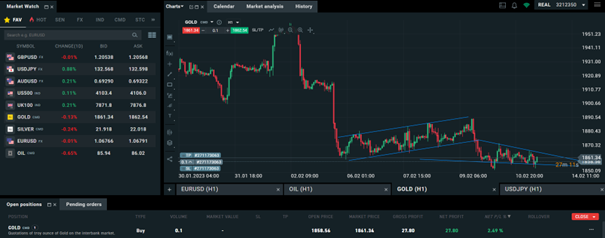Another Monday, another week for market opportunities. I woke up, made coffee, and checked the news. Many sources are claiming that despite January’s inflation was lower than before, it is now expected to get higher again. And I thought to myself, that this can only mean one thing. Possible opportunity on gold, because it was always regarded as safe haven – in other words, when inflation was rising, people intended to invest into gold. I have been following this instrument for quite some time now and saw many interesting things on the chart itself.
First, I noticed (and anyone checking the chart probably) a massive correction from about two weeks ago. The price of gold rapidly dropped from 1951 USD per ounce to current 1855 USD per ounce. * This means a 5% discount for us traders. I was checking for the reasons behind the drop, and all I could figure out was the inflation, FED and ECB meetings and of course, interest rates. When the price got steadier, I performed some technical analysis. From the chart below, I noticed the bearish channel. This channel was forming from 3rd of February until 9th of February, when my prediction turned out to be correct. When the channel “ended” it was followed by a small drop. After the price found a support level, it has again started forming another pattern – falling wedge. And if theory is any correct, after the channel closes, the price could rise.[1]
Because of volatility on the markets, I decided to do also fundamental analysis. Better be safe than sorry. As for important market events for the next 3 days, there are three things that could have major effect on the price of gold.
- Today EU will hold meetings, where they will discuss EU economic forecasts.
- Tomorrow USA will release monthly and yearly CPI which have great effect on USD and eventually on gold.
- On Wednesday ECB president Lagarde will hold speech.
So, my fundamental analysis is as follows. EU is very close to the ongoing war and members are helping financially. Meaning that there is a lot of burden on the euro. On the other hand, USA is one of the leading economies in the world, and their inflation rate is important for the price of gold. And last, ECB meeting can bring some basic volatility to the capital markets. After rereading the technical analysis and considering the fundamental part, I have decided to go with long position for short/mid long term.
*

* Past performance is no guarantee of future results
[1] Forward-looking statements are based on assumptions and current expectations, which may be inaccurate, or based on the current economic environment which is subject to change. Such statements are not guaranteeing of future performance. They involve risks and other uncertainties which are difficult to predict. Results could differ materially from those expressed or implied in any forward-looking statements.
Link to 5 year chart: https://www.investing.com/commodities/gold








